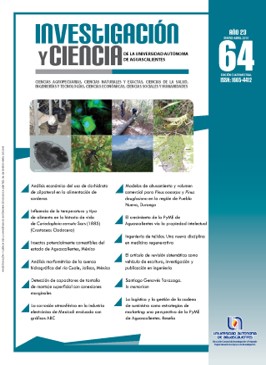Influence of temperature and food type on the life history of Ceriodaphnia cornuta Sars (1885) (Crustacea: Cladocera)
DOI:
https://doi.org/10.33064/iycuaa2015643590Keywords:
cladoceran, planktonic, life table, microalgae, temperature, reproductive valueAbstract
Cladocerans are key in the food web, contributing to nutrition of aquatic species. We determined the effect of temperature (20, 25, and 30 °C) and food type (Nannochloris oculata, Scenedesmus obliquus, and Selenastrum capricornutum) on Ceriodaphnia cornuta. Results show greater longevity and life expectancy at 20 °C, regardless of the food type. However, net reproductive rate is greater at 25-30 °C, with S. obliquus and S. capricornutum. According to the reproductive value, the highest rate of fertility and fecundity occurs with S. obliquus. The lowest values were recorded with N. oculata. Temperature is more influential than type of food for: longevity, fecundity, and fertility.
Downloads
References
• AMARASINGHE, P. et al. The effect of temperature, and food quantity and quality on the growth and development rates in laboratory-cultured copepods and cladocerans from Sri Lankan reservoir. Hydrobiologia, 350: 131-144, 1997.
• BEGON, M. et al. Ecology: Individuals, Populations, and Communities. 3 ed., Blackwell Scientific. 1068 pp., 1996.
• CHOUERI, R. B. et al. Effects of cyanobacterium exopolysaccharides on life-history of Ceriodaphnia cornuta SARs. Journal of Plankton Research, 29(4): 339-345, 2007.
• DEHUI, Z. Growth, reproduction and population growth of Ceriodaphnia cornuta Sars and comparison of 7-day fecundity with Ceriodaphnia dubia Richard. Chinese Journal of Oceanology and Limnology, 7(2): 105-111, 1989.
• DODSON, S. I. y HANAZATO, T. Commentary on Effects of Anthropogenic and Natural Organic Chemicals on Development, Swimming Behavior, and Reproduction of Daphnia, a Key Member of Aquatic Ecosystems. Environmental Health Perspectives, 103(4), 1995.
• ELÍAS GUTIÉRREZ, M. et al. Cladocera y Copepoda de las aguas continentales de México. Guía ilustrada. México: UNAM, pp. 322, 2008.
• FERRÃO FILHO, A. S. et al. Effects of essential fatty acids and N and P-limited algae on the growth rate of tropical cladocerans. Freshwater Biology, 48: 759-767, 2003.
• KUMAR, R. y HWANG, J. S. Ontogenic shifts in the ability of the cladoceran, Moina macrocopa Straus and Ceriodaphnia cornuta Sars to utilize ciliated protists as food source. International Review of Hydrobiologia, 93(3): 284-296, 2008.
• MARTÍNEZ JERÓNIMO, F. y VENTURA LÓPEZ, C. Population dynamics of the tropical cladoceran Ceriodaphnia rigaudi Richard, 1894 (Crustacea: Anomopoda). Effect of food type and temperature. Journal of Environmental Biology, 32: 513-521, 2011.
• NANDINI, S. y SARMA, S. S. S. Lifetable demography of four cladoceran species in relation to algal food (Chlorella vulgaris) density. Hydrobiologia, 435: 117-126, 2000.
• NANDINI, S. y SARMA, S. S. S. Population growth of some genera of cladocerans in relation to algal food (Chlorella vulgaris) levels. Hydrobiologia, 491: 211-219, 2003.
• NICHOLS, H. W. Growth media-freshwater. En J. R. Stein (Ed.), Handbook of Phycological Methods. Cambridge University Press, pp. 7-24, 1973.
• PORTILLA OCHOA, E. Ficha Informativa de los Humedales de Ramsar (FIR), 2003.
• PRIETO, M. Aspectos reproductivos del cladócero Moinodaphnia sp. en condiciones de laboratorio. Revista MVZ Córdoba, 6(002): 102-110, 2001.
• SAVAŞ, S. y ERDOĞAN, Ö. The Effect of Food (Scenedesmus acuminatus (von Lagerheim) R. H. Chodat) Densities and Temperature on the Population Growth of the Cladoceran Ceriodaphnia quadrangula (O. F. Muller, 1785). Journal of Fisheries & Aquatic Sciences, (1-2): 113-116, 2006.
• TORRENTERA, L. y TACON, A. G. J. Cultivo de microcrustáceos de agua dulce. En La producción de alimento vivo y su importancia en la acuacultura. Programa Cooperativo Gubernamental FAO-Italia, 1989.
• US ENVIRONMENTAL PROTECTION AGENCY. Methods for Measuring the Acute Toxicity of Effluents to Freshwater and Marine Organisms. EPA-600/4-85-013. Washington, DC: US Environmental Protection Agency, p. 159, 1985.
• VIEIRA, A. C. B. et al. Population dynamics of Moina minuta Hansen (1899), Ceriodaphnia cornuta Sars (1886), and Diaphanosoma spinulosum Herbst (1967) (Crustacea: Branchiopoda) in different nutrients (N and P) concentration ranges. Acta Limnologica Brasiliensia, 23(1): 48-56, 2011.
• VILLALOBOS, M. J. y GONZÁLEZ, E. J. Estudios sobre la biología y ecología de Ceriodaphnia cornuta Sars: Una revisión. Interciencia, 31(5): 351-357, 2005.
Downloads
Published
How to Cite
License
Copyright (c) 2015 Ignacio Alejandro Pérez Legaspi, Adriana Marisol García Villar, Mariana Garatachia Vargas, Martha Patricia Hernández Vergara, Carlos Iván Pérez Rostro, Luis Alfredo Ortega Clemente

This work is licensed under a Creative Commons Attribution-NonCommercial-ShareAlike 4.0 International License.
Las obras publicadas en versión electrónica de la revista están bajo la licencia Creative Commons Atribución-NoComercial-CompartirIgual 4.0 Internacional (CC BY-NC-SA 4.0)









